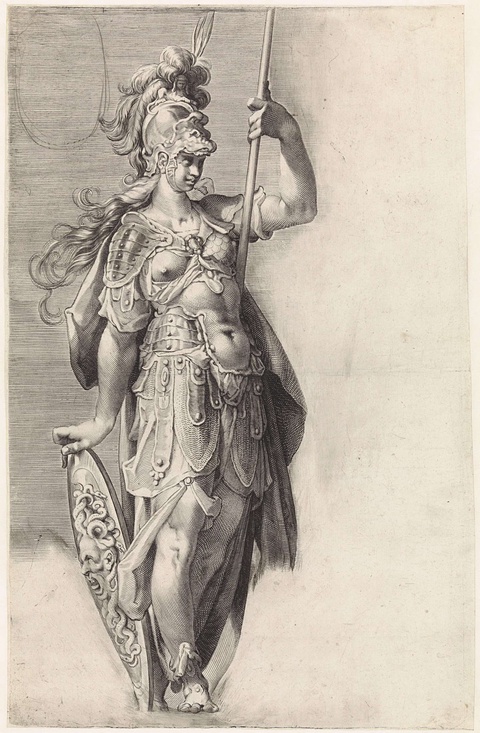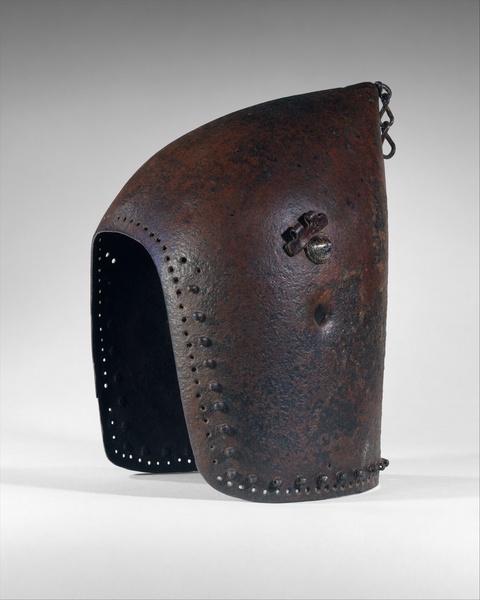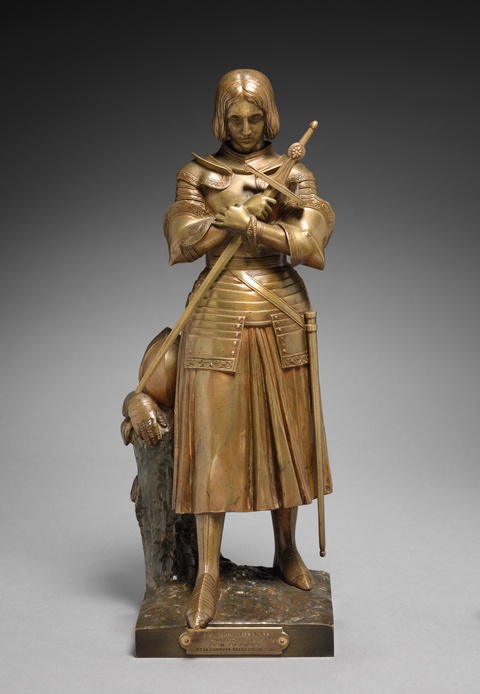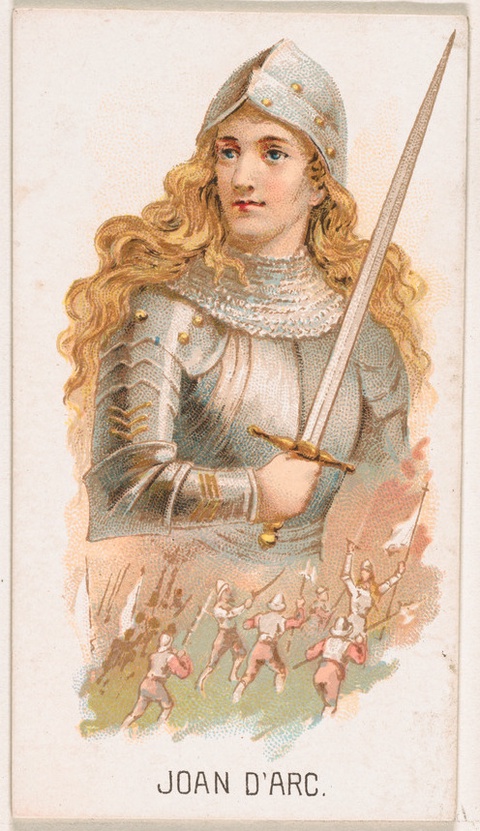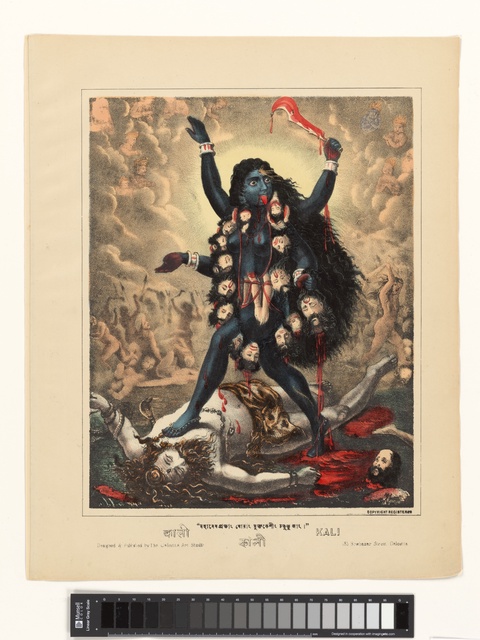Iron Women: Ancient to Early Modern Women in Armor
By Reina Gattuso•June 2022•12 Minute Read
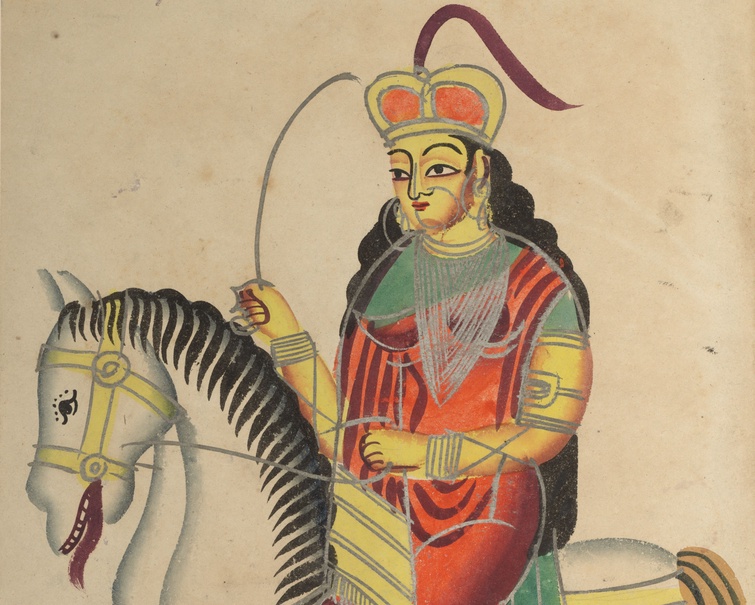
Kalighat School, The Mutiny of the Heroine Rani Lakshmi Bai of Jhansi, ca. 1890. Cleveland Museum of Art. A warrior queen from Northern India joined armed revolutionaries after the British conquered her kingdom and raided her palace.
Throughout human history, war has largely been a male pursuit. Yet women have also donned armor and charged onto the battlefield. Images of women in armor, from gender rebels to anticolonial icons, reveal cultural views about femininity, the human body, and armed conflict.
Introduction
If you watch superhero movies, you’ve likely seen women clad in scanty armor. Male action heroes often wear functional, if fashionably sculpted, plate armor. In contrast, women heroes like Wonder Woman tend to wear the equivalent of bathing suits that leave their arms, legs, and sometimes midriffs bare. In place of a solid plate over the chest, women’s fantasy armor takes the form of two sculpted, sexualized breasts, what feminist fans critically call “boob plate armor.”
Modern fantasy heroines aren’t the only women represented in unrealistic armor. For example, Minerva, the Roman goddess of war, was often depicted in a similarly sexualized getup.
This design isn’t just impractical and sexist—it’s downright dangerous.1 Plate armor is specifically designed to rebuff swords, directing blows away from the heart and lungs. “If you’ve got two hemispheres and then a canyon in the center, that’s just going to direct swords right toward the center,” says Dr. Chassica Kirchhoff, Assistant Curator of European Sculpture and Decorative Arts at the Detroit Institute of Arts.2
Across human cultures, men are much more likely to fight in wars than women,3 and representations of historical women in combat are scarce. When women are represented in armor, the images tell us about that society’s relationship to the idea of female military power.
(In this article, “women” is a placeholder term for a range of bodies and gender identities that fall outside of people we would, in contemporary English, call cisgender men.)
Ghostly Bodies
Armor can be made of many different materials. “Essentially, any time we say armor, we mean a defensive surface that you wear on your body,” says Kirchhoff.
That can include layered textiles, boiled and hardened leather, mail (interlocking steel rings), and plate armor made of sheets of metal. In medieval and renaissance Europe, soldiers preferred plate armor. In neighboring Asian and North African empires, such as those of the Ottomans, Mughals, and Mamluks, soldiers preferred mail.4
We have more surviving examples of mail and plate armors than of textile and leather armors because metal is less biodegradable. Plate armor creates a lasting record of the size and shape of a wearer. “When you have an armor completely assembled, it becomes like a ghostly body,” says Kirchhoff. Mail shirts leave a similar, though more flexible, imprint.
Armor combines fashion with functionality in an idealized form. “Armor becomes a vessel of identity in so many ways,” Kirchhoff says. Centuries later, we can study these vessels to understand a particular culture’s attitude toward gender, the body, and war.
Armor, Gender, and Class
Historically, owning metal armor was a marker of status. “To wear armor from head to toe on your body is not only a declaration of material wealth,” says Kirchhoff, “but evidence of control of human and natural resources.”
Armor reflected the gendered qualities associated with battle, usually masculinity. 16th-century European armor, for example, featured wide shoulders and exaggerated codpieces that covered and emphasized the penis and testicles. These features were functionally unnecessary, but symbolically exaggerated masculine ideals. Kirchhoff calls this an aesthetic of “performed impermeability,” the idea that an ideal male soldier is invulnerable.
In contrast, artists often depicted women in armor as comical or sexual. A common medieval trope portrayed women jousting with distaffs, spindles for spinning wool. Such an image implies that women are only suited for “women’s work” like spinning, not the masculine realm of bloodsports.
Master ES, Jousting with Distaffs, 1450-1467. British Museum, CC BY-NC-SA 4.0 License. This medieval European print reveals a comical and arguably sexist trope in which a naked man on a unicorn and a naked woman on a horse are jousting.
Meanwhile, images of Minerva in skimpy armor emphasized her femininity, which European cultures associated with vulnerability and receptiveness. “When your midriff is exposed, you are not impermeable,” Kirchhoff says.
Women Warriors in the Archeological Record
Historical women fought in battles and wore armor, though much less frequently than men. In Europe, armor designs for women would have been similar to that of men of similar stature. There was no specific molding around the breasts. It's impossible for us to know the gender of the wearer from the armor alone. We don’t have any examples of European plate armor that can be definitively tied to a woman wearer.
In Japan, women occasionally became samurai. There are a few surviving examples of do maru armor that legend, and some art historians, connect to women wearers. Do maru is a style of light armor designed for fighting on foot.
Sexist Misreadings of the Archive
In 2013, archeologists in Italy found an ancient Etruscan woman buried with a spear. Yet archeologists initially assumed that the weapon belonged to the man buried with her. Their bias that women can’t be warriors distorted their interpretation of material evidence.5
Similarly, says Kirchhoff, when Victorian-era art historians looked at armor made by 15th-century German armorer Lorenz Helmschmied, they assumed the elongated, thin silhouettes were feminine. In fact, that was simply the design considered masculine in that time and place.
Women Armor Makers
Despite patriarchal pressures, women made armor as well as wore it.
There’s evidence of women running armor-making workshops 13th- and 14th-century Europe, most often when they took over from their fathers or husbands. As plate armor became more popular, guilds strictly controlled who could make crafts, and they excluded women. Guilds began to fine armor makers for including women in their workshops.6
More often, European women made textile armor. We don’t have many of these objects in museum collections. Women were more likely to make objects out of materials which degraded quicker, and which treasurers and historians were less likely to preserve.
In Japan, armor and weapon making was similarly a mostly male pursuit. However, there is evidence of occasional women swordsmiths. Because of gender discrimination, buyers would have been much less inclined to purchase a sword made by a woman, so most women didn’t sign their names to their swords. Onna Kunishige, an 18th-century swordsmith, is the only woman known to have signed her swords.7
Women Warriors as National Icons
There were not many representations of historical women warriors. The few that do exist are by male artists, who tend to depict these women as icons representing a culture or nation.
Samurai Tomoe Gozen is one of the most famous onna-musha, or women warriors, in Japanese myth. She appears in the Heike Monogatari, Japan’s earliest written epic, which characterizes her as a valiant warrior and a great beauty.
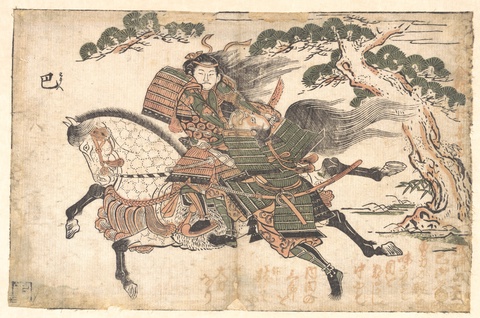
Today, Tomoe Gozen often appears as a character in pop culture. She remains a model of both grace and martial might.
Few objects attributed to women warriors have survived. Ancient writers noted that the Celtic Queen Boudicca, who successfully led an army against the invading Romans in the 1st century CE, wore a gold neck ring like the one above. Celtic people believed these rings had protective power, making them a kind of spiritual armor.
Case Study: Gender Transgression and Joan of Arc
Joan of Arc is perhaps the most iconic European woman soldier. There is one image of her from her lifetime, produced by an artist who likely never met her. She is not wearing armor in that image. However, there is a written record that she did own and wear armor, as she donated one set of plate armor to the French Royal Abbey.
There is also an existing helmet attributed to Joan of Arc. That story only goes back to the 19th century and is likely untrue. However, the story shows us that 19th-century French people honored Joan of Arc.
Joan of Arc chose to wear masculine clothing both on and off the battlefield. “She was extremely transgressive in her self-presentation,” says Kirchhoff. “It’s one of the main points for which she was condemned.”
Indeed, the English forgave her original charge of heresy on the condition that she would stop wearing men’s clothing. Within a few days, however, she resumed wearing men’s clothing and claiming to hear the voice of God. The English executed her.8
Jean Pichore, Jeanne d'Arc, 1506. Wikimedia Commons from Musée Dobrée, public domain. Parisian manuscript illuminator Pichore painted this early depiction of Joan of Arc to illustrate The Lives of Famous Women, composed in 1504 by Antoine Du Four.
Some images of Joan of Arc respect this masculine gender presentation. One painting made a mere 70 years after her death presents her as a gender neutral figure in full armor. A French illuminated manuscript painter created it for a book of brave women.
An 18th-century sculpture by Marie-Christine d’Orleans, a princess of France, depicts Joan as a pious leader. Her body leans androgynous. She has cropped hair, which in medieval Europe indicated humility or defeat. Her sexuality takes a backseat to her piety as she prayerfully clasps her sword.
This is a rare depiction of Joan of Arc by a woman. As a French royal, Princess Marie-Christine likely had an interest in presenting a noble depiction of Joan as her nationalist female forebear.
The above image, from a late 19th-century U.S. cigarette advertisement, presents Joan with flowing blond hair. While the armor characterizes her as an active soldier, the hair marks her femininity. Perhaps the detail was an attempt to resolve the tension between valor and gender expectations of that era.
Anticolonial Heroes
In colonial contexts, armor-clad women can be figures of resistance.
Laxmibai, the Rani of Jhansi, ruled over a small North Indian kingdom in the mid-1800s. When the British annexed her kingdom and sacked her palace, she joined the Rebellion of 1859. The British killed her and crushed the rebellion, but her story and image became anticolonial propaganda.
Laxmibai is depicted here in an 1890 Kalighat painting. Artists who congregated near the Kalighat temple in Kolkata developed this style, an accessible form of art addressing both religious and popular topics. By 1890, Kolkata had become a center of anticolonial resistance, imbuing this image of Jhansi ki Rani with an Indian nationalist message.
In 19th-century India, lithography enabled the rise of a popular visual culture, including religious images. Religious images often doubled as nationalist propaganda, as in the example of Bharat Mata (Mother India). Propagandists within the late 19th and early 20th century Indian nationalist movement often equated women freedom fighters like Laxmibai with militant Hindu goddesses like Kali, the ferocious destroyer.
Images of nationalist women as fierce goddesses can signify majoritarian dominance as well as anti-colonial resistance.
Hindu supremacist organizations like the paramilitary Rashtriya Swayamsevak Sangh (RSS) use images of fighting goddesses to incite brutal Islamophobic and casteist violence. The Durga Vahini, the women’s wing of the RSS, employs imagery of the warrior goddess Durga in particular to promote the organization’s brutal anti-Muslim militancy.9
Seen and Unseen Warriors
Historical armor, and art depicting women in armor, can help us understand past attitudes and beliefs about gender and war. Yet the picture will always be incomplete.
The majority of historical people who fought in wars, including women, could not afford the expensive plate armor held in museum collections today. Armor indicates that the person wearing it commanded resources, and that they had a life those around them believed was worth saving.
In contrast, we don’t have material evidence of the majority of poor and marginalized people who fought in wars without expensive protection. Material evidence like suits of armor tells us about the bodies and people who used them. But we also have another task: to imagine the people who were not valued highly enough to leave armor behind.
Reina Gattuso is a content writer on the Curationist team, and an independent journalist covering gender and sexuality, arts and culture, and food. Her journalism connects analysis of structural inequality to everyday stories of community, creativity, and care. Her work has appeared at Atlas Obscura, The Washington Post, Teen Vogue, The Lily, POPSUGAR, and more. Reina has an MA in Arts and Aesthetics (cinema, performance, and visual studies) from Jawaharlal Nehru University in New Delhi, India, where her research focused on sexuality in Hindi film. She writes and teaches writing to high school students in New York City.
Suggested Readings
Sexism in Fantasy
Davis, Lauren. "What kind of armor did Medieval women really wear?” Gizmodo, 16 January 2014, https://gizmodo.com/what-kind-of-armor-did-medieval-women-really-wear-1502779338.
Asher-Perrin, Emmet. “It’s time to Retire ‘Boob Plate Armor.’ Because It Would Kill You.” Tor.com, 6 May 2023, https://www.tor.com/2013/05/06/boob-plate-armor-would-kill-you/.
Women Armor Scholars
Webb, Jessica Johnson. “DIA’s first female armor specialist digs into history to discover the secrets behind medieval suits.” Roadtrippers, 23 July 2021, https://roadtrippers.com/magazine/dia-suits-of-armor/.
Material Evidence of Women in Arms
Ghose, Tia. “Oops! Etruscan Warrior Prince Really a Princess.” Livescience, 18 October 2013, https://www.livescience.com/40530-etruscan-warrior-prince-is-a-princess.html.
Mead, Claire. “Femininity weaponised: A history of women and swords in art.” Art UK, 23 September 2020, https://artuk.org/discover/stories/femininity-weaponised-a-history-of-women-and-swords-in-art.
Breiding, Dirk H. “Arms and Armor—Common Misconceptions and Frequently Asked Questions.” The Metropolitan Museum of Art, October 2004, https://www.metmuseum.org/toah/hd/aams/hd_aams.htm.
Citations
Davis, Lauren. “What kind of armor did Medieval women really wear?” Gizmodo, 16 January 2014, https://gizmodo.com/what-kind-of-armor-did-medieval-women-really-wear-1502779338. Accessed 19 March 2022.
Kirchhoff, Chassica. Interview with Reina Gattuso for Curationist. 18 January 2022.
Micheletti, Alberto J. C., Graeme D. Ruxton, and Andy Gardner. “Why war is a man’s game.” Proceedings of the Royal Society, 285 (1884), 15 August 2018, https://royalsocietypublishing.org/doi/10.1098/rspb.2018.0975. Accessed 19 March 2022.
“Islamic Arms and Armor.” The Metropolitan Museum of Art, October 2004, https://www.metmuseum.org/toah/hd/isaa/hd_isaa.htm. Accessed 19 March 2022.
Ghose, Tia. “Oops! Etruscan Warrior Prince Really a Princess.” Livescience, 18 October 2013, https://www.livescience.com/40530-etruscan-warrior-prince-is-a-princess.html. Accessed 19 March 2022.
Kirchhoff.
Boyett, Colleen, H. Micheal Tarver, Mildred Diane Gleason, eds. “Feudal Japan.” Daily Life of Women: An Encyclopedia from Ancient Times to the Present, Greenwood Publishing Group, 2020, pp. 393. Google Books, https://www.google.com/books/edition/Daily_Life_of_Women_An_Encyclopedia_from/e14MEAAAQBAJ?hl=en&gbpv=1&dq=Onna+Kunishige&pg=PA393&printsec=frontcover. Accessed 19 March 2022.
Crane, Susan. “Clothing and Gender Definition: Joan of Arc.” Journal of Medieval and Early Modern Studies, 26 (2), 1996, pp. 227-300, http://faculty.smu.edu/bwheeler/joan_of_arc/olr/08_clothingjoanofarc_crane.pdf. Accessed 19 March 2022.
Jain, Kalpana. “Good Wives, Good Soldiers: Durga Vahini Women Take Up Arms to Protect Hindu Identity.” Pulitzer Center, 15 November 2019, https://pulitzercenter.org/stories/good-wives-good-soldiers-durga-vahini-women-take-arms-protect-hindu-identity. Accessed 19 March 2022.
Reina Gattuso is a content writer on the Curationist team, and an independent journalist covering gender and sexuality, arts and culture, and food. Her journalism connects analysis of structural inequality to everyday stories of community, creativity, and care. Her work has appeared at Atlas Obscura, The Washington Post, Teen Vogue, The Lily, POPSUGAR, and more. Reina has an MA in Arts and Aesthetics (cinema, performance, and visual studies) from Jawaharlal Nehru University in New Delhi, India, where her research focused on sexuality in Hindi film. She writes and teaches writing to high school students in New York City.
